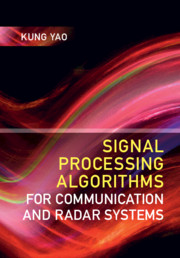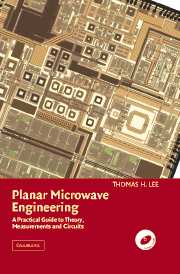Refine search
Actions for selected content:
1562 results in RF and microwave engineering
14 - Systolic Array Design by Dependence Graph Mapping
-
- Book:
- Signal Processing Algorithms for Communication and Radar Systems
- Published online:
- 25 April 2019
- Print publication:
- 02 May 2019, pp 281-293
-
- Chapter
- Export citation
15 - Systolic Array Processing for Least-Squares Estimation
-
- Book:
- Signal Processing Algorithms for Communication and Radar Systems
- Published online:
- 25 April 2019
- Print publication:
- 02 May 2019, pp 294-316
-
- Chapter
- Export citation
16 - Systolic Algorithms and Architectures for Communication and Radar Systems
-
- Book:
- Signal Processing Algorithms for Communication and Radar Systems
- Published online:
- 25 April 2019
- Print publication:
- 02 May 2019, pp 317-325
-
- Chapter
- Export citation
13 - Introduction to Systolic Arrays
-
- Book:
- Signal Processing Algorithms for Communication and Radar Systems
- Published online:
- 25 April 2019
- Print publication:
- 02 May 2019, pp 269-280
-
- Chapter
- Export citation
Frontmatter
-
- Book:
- Signal Processing Algorithms for Communication and Radar Systems
- Published online:
- 25 April 2019
- Print publication:
- 02 May 2019, pp iii-vi
-
- Chapter
- Export citation
Endorsements
-
- Book:
- Signal Processing Algorithms for Communication and Radar Systems
- Published online:
- 25 April 2019
- Print publication:
- 02 May 2019, pp i-ii
-
- Chapter
- Export citation
12 - Quantization, Saturation, and Scaling
-
- Book:
- Signal Processing Algorithms for Communication and Radar Systems
- Published online:
- 25 April 2019
- Print publication:
- 02 May 2019, pp 247-268
-
- Chapter
- Export citation
2 - Discrete Fourier Transform, Fast Fourier Transform, and Convolution
-
- Book:
- Signal Processing Algorithms for Communication and Radar Systems
- Published online:
- 25 April 2019
- Print publication:
- 02 May 2019, pp 7-20
-
- Chapter
- Export citation
Contents
-
- Book:
- Signal Processing Algorithms for Communication and Radar Systems
- Published online:
- 25 April 2019
- Print publication:
- 02 May 2019, pp ix-xiv
-
- Chapter
- Export citation

Signal Processing Algorithms for Communication and Radar Systems
-
- Published online:
- 25 April 2019
- Print publication:
- 02 May 2019

Planar Microwave Engineering
- A Practical Guide to Theory, Measurement, and Circuits
-
- Published online:
- 30 January 2019
- Print publication:
- 30 August 2004
-
- Textbook
- Export citation
8 - Antennas
-
- Book:
- Foundations of Radio for Scientists and Technologists
- Published online:
- 22 August 2018
- Print publication:
- 23 August 2018, pp 150-182
-
- Chapter
- Export citation
6 - Digital Techniques and Software-Defined Radio
-
- Book:
- Foundations of Radio for Scientists and Technologists
- Published online:
- 22 August 2018
- Print publication:
- 23 August 2018, pp 110-128
-
- Chapter
- Export citation
4 - Amplification
-
- Book:
- Foundations of Radio for Scientists and Technologists
- Published online:
- 22 August 2018
- Print publication:
- 23 August 2018, pp 53-82
-
- Chapter
- Export citation
Preface
-
- Book:
- Foundations of Radio for Scientists and Technologists
- Published online:
- 22 August 2018
- Print publication:
- 23 August 2018, pp ix-x
-
- Chapter
- Export citation
10 - Modern Radio Systems
-
- Book:
- Foundations of Radio for Scientists and Technologists
- Published online:
- 22 August 2018
- Print publication:
- 23 August 2018, pp 206-224
-
- Chapter
- Export citation
1 - Electromagnetism
-
- Book:
- Foundations of Radio for Scientists and Technologists
- Published online:
- 22 August 2018
- Print publication:
- 23 August 2018, pp 1-20
-
- Chapter
-
- You have access
- Export citation
7 - Transmission Lines
-
- Book:
- Foundations of Radio for Scientists and Technologists
- Published online:
- 22 August 2018
- Print publication:
- 23 August 2018, pp 129-149
-
- Chapter
- Export citation
3 - Tuned Circuits
-
- Book:
- Foundations of Radio for Scientists and Technologists
- Published online:
- 22 August 2018
- Print publication:
- 23 August 2018, pp 39-52
-
- Chapter
- Export citation
Frontmatter
-
- Book:
- Foundations of Radio for Scientists and Technologists
- Published online:
- 22 August 2018
- Print publication:
- 23 August 2018, pp i-iv
-
- Chapter
- Export citation
